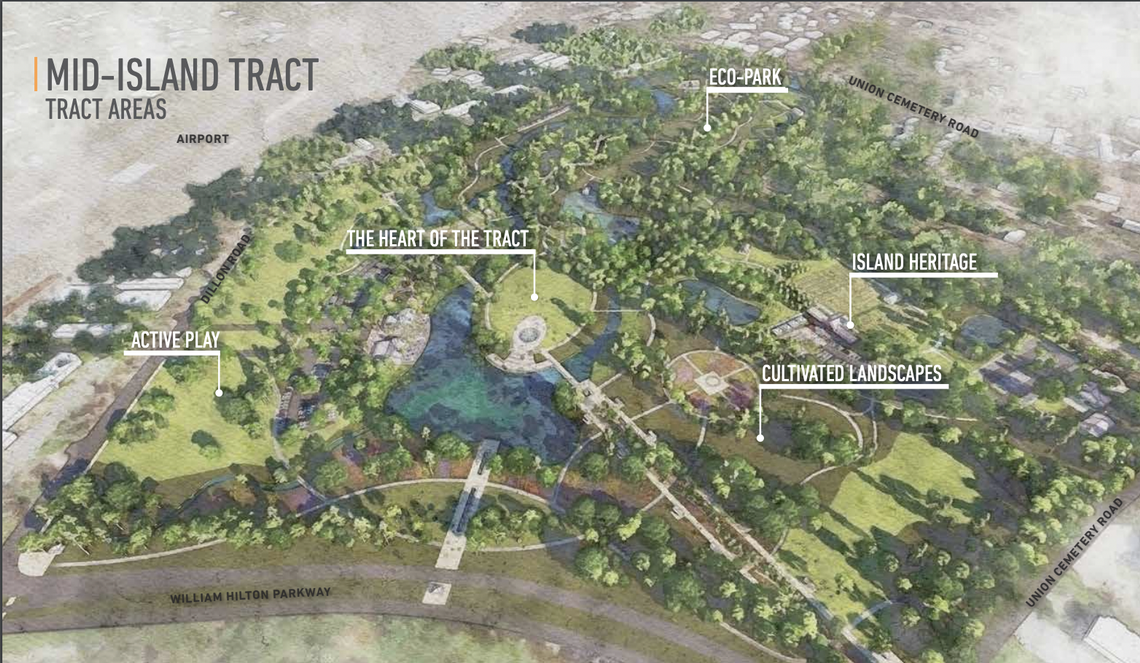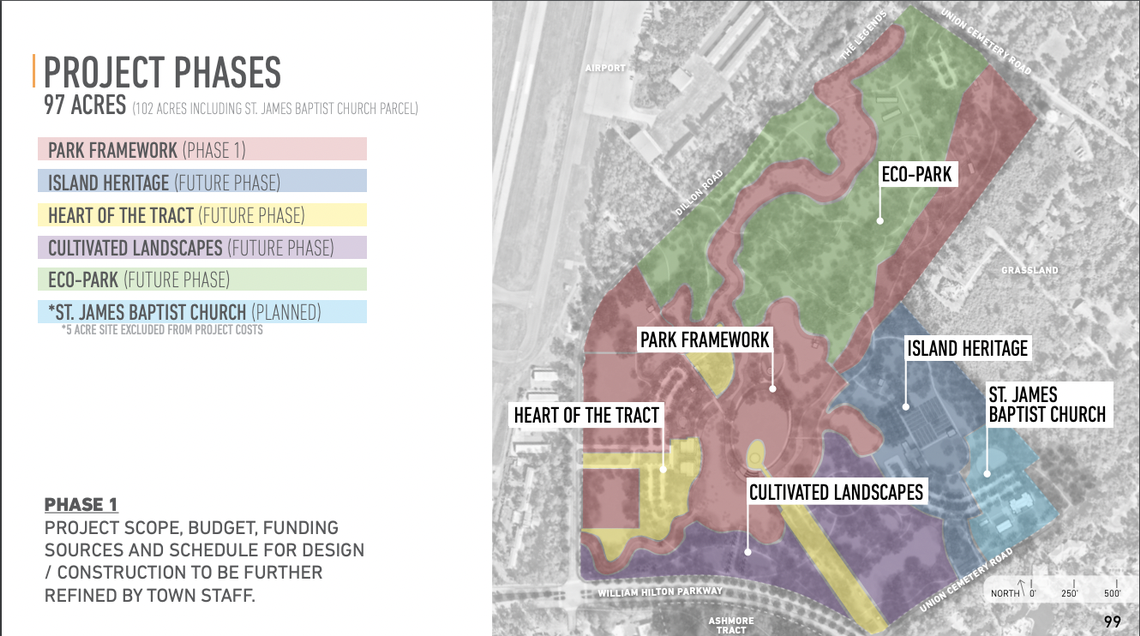Hilton Head approves plans for the Mid-Island Tract park project. Here’s what happens next
Nearly a decade after purchasing land, the Town of Hilton Head has formally approved plans to proceed with the mid-island tract project, which developers hope will offer a “best-in-class park” for island residents and tourists.
Bordered by William Hilton Parkway, Union Cemetery Road and Dillion Road, the 103-acre tract was formerly the Planters Row Golf Course. The town bought the property for $5 million in 2013 and hired consulting firm MKSK last year to draw up development plans.
Now that the initial plan has been approved, the town will work with MKSK to create a detailed design and set a budget for the project’s first phase of construction.
The park’s development is planned in five phases, according to the town’s master plan. Phase 1, meant to serve as the park’s “framework,” covers only a small portion of the land and includes mostly open outdoor areas, while later developments will expand the park to include indoor event spaces, recreational facilities and cultural landmarks.
No start or end dates have been projected for the park’s construction, according to Jennifer Ray, the town’s capital program manager. The project’s 2022 budget allocation has construction for Phase 1 slated for fiscal year 2023 and continuing into 2024 and beyond.
“We know it’s a multi-year project,” Ray said.
Mayor John McCann called the project a “visionary plan” that will transform the island’s center, according to previous reporting from The Island Packet and Beaufort Gazette.

What’s included in the plan?
After Phase 1, the project’s remaining parts can be completed in any order, Ray said. Ultimately, the Town Council will decide which parts to prioritize and how to proceed.
Here’s a brief rundown of the project’s phases — and what’s included in each:
Active Play (Phase 1)
Entry and parking
Trails
Playground
“Great Lawn” for natural play
Dog park
Island Heritage
Community cultural gardens
Picnic pavilion
Garden shed
Event lawn
Open-air market
The Heart of the Tract
Sculptural fountain
Multi-use community facility
Playground
Bocce ball courts
Interactive water feature
Cultivated Landscapes
Open lawn
Lowcountry botanical gardens
Monet garden
Promenade and fountains
Eco-Park
Observation deck
Habitat restoration
Boardwalk
Canopy walk
Eco-center
Located just south of the main tract, the smaller Ashmore Tract will be connected to the park via a pedestrian bridge that crosses William Hilton Parkway. Ashmore Tract is planned to feature an 18-hole disc golf course, footgolf fields and a pavilion. A cost for these additions has not yet been projected, Ray said.
Ray also noted that even during periods of construction, island residents and visitors will always have access to certain parts of the property. During development of Phase 1, for example, visitors will still be able to utilize other parts of the 103-acre parcel for recreational use.
Also included in the park’s borders is a 5-acre area designated for the future St. James Baptist Church, which is moving from its spot on Dillon Road after Hilton Head Airport’s 700-foot runway addition put the church inside the federally mandated “runway protection zone.” Church officials are also making plans to move the nearby Cherry Hill School to the new property, Ray said.
“I think we will be much safer at that location,” said Blewett Wright, an eight-year member of the church and the leader of its negotiating committee.
St. James Baptist Church is the oldest continuously operating cultural institution remaining in Mitchelville, the north-end village established for freed slaves in 1886. The Cherry Hill School was built in 1937 and is the last remaining schoolhouse built solely for African American children on the island.

How much will it cost?
Without specific plans for Phase 1 of construction, finding an exact cost estimate is difficult, Ray said. But early projections put the park’s price tag between $48 million and $71 million, according to figures from the master plan.
The $23 million difference between those two numbers, Ray explained, lies in the master plan’s “enhancement costs,” or extra expenditures that could be removed if necessary, such as an interactive water feature or a dog park. Costs were organized this way to give the Town Council flexibility in setting the budget for the park.
The town still doesn’t know exactly how funds for the park will be collected, Ray said, though private donations, government grants and taxpayer funds are all being considered. Of the $5.2 million allocated for the park’s preliminary surveys, planning and design, $4.6 million was collected through the island’s hospitality tax.
What about workforce housing?
Some islanders and local officials question whether the park project could be better utilized for residential space. Early this year, Town Council member David Ames of Ward 3 urged his colleagues to consider using 20 acres off Dillon Road for a workforce housing project.
“103 acres on this piece of ground should incorporate affordable housing in one way or another,” Ames told the Town Council in February.
But Ames’ suggestion was shot down by several council members, as well as Brian Kinzelman, a principal at MKSK.
“It is our recommendation ... that we do not use this open space for housing,” Kinzelman said, arguing there are other areas on the island that could be utilized for a housing project.
According to Ray, the Town Council also received “legal advice” from the town’s attorney that the funding sources used to purchase the property would not support building housing on the land.
In an October 2021 survey on potential usage for the land, about 68% of town residents said a park was missing from the mid-island area, while about 35% said residential amenities or workforce housing were missing.